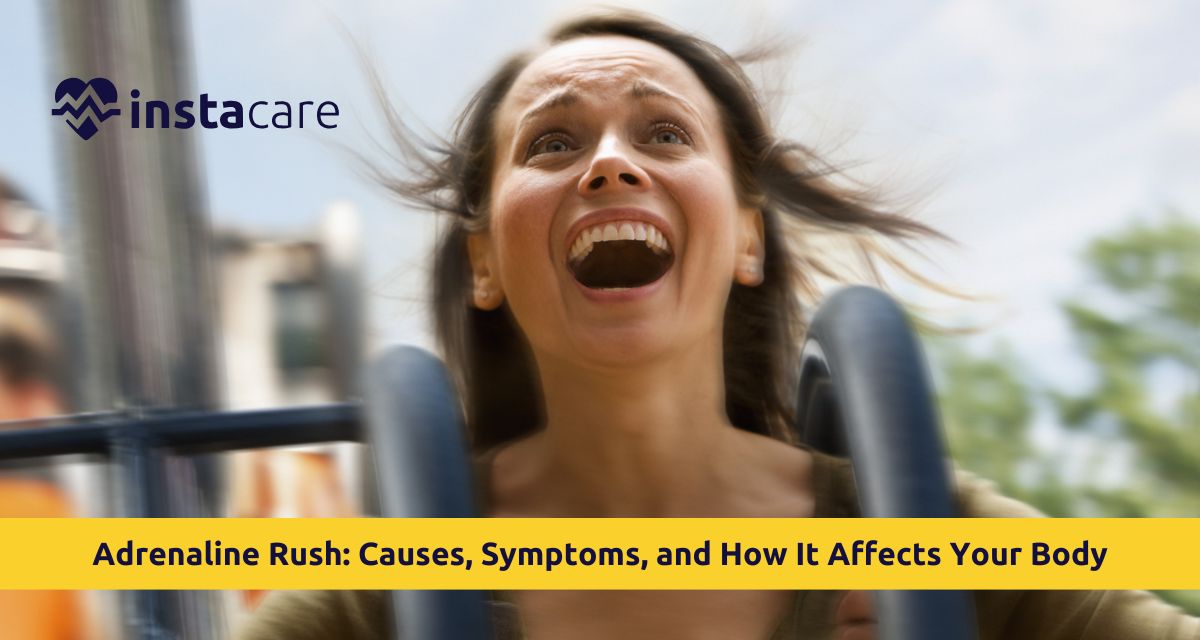Have you ever breathed in, puffed a racing heart, and stiffened up anticipating a test, presentation, or near-fiasco disaster? That shocking brief moment is what is adrenaline rush? It is the instant body reaction to tension or excitement, the climax of the primitive fight or flight response. While occasional bursts of adrenaline sharpen focus and rapid response, overrelease or repeated release are more detrimental.
Learning about the causes of adrenaline rush, how it is triggered, and what happens within your body during a rush is essential. The biological process of adrenaline, symptoms of adrenaline rush, its impacts on your body, and the best coping strategies available to bounce back and move beyond your feelings are covered in this book.
What Is Adrenaline?
Adrenaline, or epinephrine, is a hormone as well as a neurotransmitter secreted by the adrenal glands located at the top of the kidneys. Upon detection of hazard,
stress, or excitement, the brain stimulates the release of adrenaline into the blood by the glands. The hormone preconditions the body ahead of time so that it can respond promptly by setting off a cascade of physical processes with the aim of improving the chances of survival.
Adrenaline effects on the body include preparing you for action in seconds, it stimulates energy, speed, and focus when it matters most. Adrenaline is the main actor of the fantasy world of the sympathetic nervous system, which activates the fight or flight of your body. It prepares you for a ride in a flash but you're quicker and sharper.
Why an Adrenaline Rush Happens
There are thousands of emotional, physical, and environmental stimuli that stimulate a sudden adrenaline surge. They include:
- Stress: Anger, adrenaline and anxiety can be present during certain situations - anxiety, fear, or anticipation, especially when they can be dangerous.
- Thrills and suspense: Watching a horror movie, skydive or roller coaster trip are bound to give the surge of adrenaline.
- Fear for pain or injury: It signals the brain that any pain, injury, or danger will prepare it to react immediately.
- Competitive sports: Competitive activity requiring a quick response or intense bodily exertion must include the release of some adrenaline.
- Physical labor: Adrenaline is also stimulated during hard exercise.
Adrenaline in extreme sports is a well-known phenomenon; many pursue it for the thrill and stimulation.
Even someone giving a speech in front of many people or doing well on a hard exam will feel a surge of adrenaline in the beginning.
Symptoms of the Classic Adrenaline Rush
When the adrenaline hits your system, your body responds in typical manners. The most frequent symptoms of adrenaline rush are:
- Racing heart: The heart has to race to send oxygen to the muscles.
- Rapid breathing: It's deeper and faster to deliver more oxygen to the blood.
- Pupil dilation: Eyes are getting ready to work at high concentration.
- Sweat: Your body is getting ready to cool down by losing heat while being utilized.
- Shaking or trembling: Muscles tense and ready to move rapidly.
- Dry mouth: Salivation is reduced in anxiety.
- Sudden release of energy: You feel a burst of energy, quickness, or increased sensitivity.
- Tunnel vision or concentration to excess: Concentration narrows to closest proximity.
In other people, the symptoms blend or balloon to evolve into adrenaline and panic attacks, particularly with anxious individuals.
How Adrenaline Rush Works in Your Body
The physical response of the body to adrenaline is quite dramatic and almost simultaneous. Released, adrenaline sets off a sequence of events to prepare the body to cope with danger or dangerous behavior:
- Cardiovascular system: The hormone stimulates a rise in adrenaline and heart rate to circulate more blood into the body.
- Respiratory system: Airways widen so more oxygen comes into the lungs.
- Muscular system: Muscles contract, prepared to respond within a fraction of time.
- Digestive system: Digestion becomes slower temporarily in an attempt to save energy.
- Brain activity: Reaction accelerates, senses are fine-tuned, perception becomes acute.
The effects of too much adrenaline, however, particularly when unnecessary or prolonged, include health risks such as hypertension, anxiety, and sleep disruption.
When Is an Adrenaline Rush a Health Concern
Adrenaline rush can be anticipated occasionally at random. It is a medical condition, but if too frequent, for too long a period as required, or to harmless stimuli. Symptoms and signs are:
- Daytime restlessness or irritability
- Tachycardic attacks on regular basis
- Nightmares or insomnia due to sleeping disorder
- High rate of panic attacks
- Sudden explosion without physical or emotional stimulus
- Gastric problems, i.e., nausea on stress
Under such a circumstance, the best is to look for underlying diseases like chronic stress, trauma, or anxiety disorders. If adrenaline and anxiety are not treated, they have a tendency to cripple normal functioning and create more long-term health danger.
Regulation of Adrenaline Rush
Knowing how to control adrenaline rush is the greatest way of giving physical and emotional reassurance. Although you cannot prevent adrenaline release from occurring in the first place, you can respond to it.
Deep Relaxation and Breathing Exercises
Meditate, do yoga, or diaphragmatic breathing. These therapies stimulate the parasympathetic nervous system, the reverse of fight-or-flight, and settle the body down.
Regular Exercise
Basal tension and hormone release and level reduce with continuous exercise. Low-key exercise such as swimming or a walk is best to de-arouse excess adrenaline.
Caffeine and Decrease of Sugar
Stimulants will create adrenaline responses. Caffeine, energy drinks, and processed reduction of sugar reduces the occurrence of unwanted spikes.
Balanced Nutrition
Magnesium food diet, healthy fats, and protein stabilize the nervous system. Never skip meals, which puts stress on the body.
Sleep Hygiene
Sleep 7–9 hours of quality sleep every night. Low-quality sleep induces more stress chemicals such as adrenaline and cortisol.
Therapy and Counseling
In case adrenaline rushes are accompanied by panic attacks or trauma, professional therapy in the form of cognitive behavior therapy (CBT) can treat underlying emotional problems.
Natural adrenaline boosters (Moderation)
Natural energy boosters like cold showers, ear-bleeding music, or spicy food in moderation, always in safe places and moderation for those who dislike unhealthy energy spikes.
Adrenaline vs Cortisol: What’s the Difference?
They are both stress hormones, but adrenaline vs cortisol work very differently from each other:
- Adrenaline is quick. Peaking in minutes, it has an extremely short half-life.
- Cortisol comes later but also lingers. The body utilizes cortisol to adapt to stress in the long term through control of the metabolism, blood sugar, and inflammation.
Either of the two hormones when excessive is harmful but typically secreted together for responding to stress.
Adrenaline effects on the body can be both life-saving and, if uncontrolled, damaging over time.
Conclusion
Adrenaline rush is the wits of the body's survival strategy. To rescue oneself from harm or to pursue something that scares but is thrilling, the hormone builds a burst of energy, clear thinking, and stamina. But when it happens repeatedly or continues to happen too often, there are certain lasting repercussions one needs to be mindful of like anxiety, heart disease, and hormonal imbalance.
To know how to identify causes of adrenaline rush, why they happen, and how to use relaxation techniques is the secret of competence in an adrenaline world. When you are afraid or trying to get a high from risk sport, competence with adrenaline enables you to perform better, body and mind both, at lesser long-term cost.
Please book an appointment with the
best Endocrinologist in Lahore, Karachi, Islamabad, and all major cities of Pakistan through
InstaCare, or call our helpline at 03171777509 to find the verified doctor for your disease.

